
Pac-Man, originally called Puck Man in Japan, is a 1980 maze action video game developed and released by Namco for arcades. In North America, the game was released by Midway Manufacturing as part of its licensing agreement with Namco America. The player controls Pac-Man, who must eat all the dots inside an enclosed maze while avoiding four colored ghosts. Eating large flashing dots called "Power Pellets" causes the ghosts to temporarily turn blue, allowing Pac-Man to eat them for bonus points.

Marble Madness is an arcade video game designed by Mark Cerny and published by Atari Games in 1984. It is a platform game in which the player must guide a marble through six courses, populated with obstacles and enemies, within a time limit. The player controls the marble by using a trackball. Marble Madness is known for using innovative game technologies: it was Atari's first to use the Atari System 1 hardware, the first to be programmed in the C programming language, and one of the first to use true stereo sound.

Joust is an action game developed by Williams Electronics and released in arcades in 1982. While not the first two-player cooperative video game, Joust's success and polished implementation popularized the concept. Players assume the role of knights armed with lances and mounted on large birds, who must fly around the screen and defeat enemy knights riding buzzards.
Racing games are a video game genre in which the player participates in a racing competition. They may be based on anything from real-world racing leagues to fantastical settings. They are distributed along a spectrum between more realistic racing simulations and more fantastical arcade-style racing games. Kart racing games emerged in the 1990s as a popular sub-genre of the latter. Racing games may also fall under the category of sports video games.
A sports video game is a video game that simulates the practice of sports. Most sports have been recreated with video games, including team sports, track and field, extreme sports, and combat sports. Some games emphasize playing the sport, whilst others emphasize strategy and sport management. Some, such as Need for Speed, Arch Rivals and Punch-Out!!, satirize the sport for comic effect. This genre has been popular throughout the history of video games and is competitive, just like real-world sports. A number of game series feature the names and characteristics of real teams and players, and are updated annually to reflect real-world changes. The sports genre is one of the oldest genres in gaming history.

Defender is a horizontally scrolling shooter video game developed by Williams Electronics in 1980 and released for arcades in 1981. The game is set on either an unnamed planet or city where the player must defeat waves of invading aliens while protecting astronauts. Development was led by Eugene Jarvis, a pinball programmer at Williams; Defender was Jarvis's first video game project and drew inspiration from Space Invaders and Asteroids. Defender was demonstrated in late 1980, before entering production in early 1981. It was distributed in Japan by Taito.
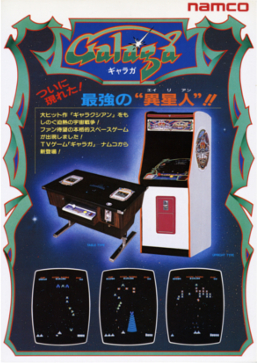
Galaga is a 1981 fixed shooter arcade video game developed and published by Namco. In North America, it was released by Midway Manufacturing. It is the sequel to Galaxian (1979), Namco's first major video game hit in arcades. Controlling a starship, the player is tasked with destroying the Galaga forces in each stage while avoiding enemies and projectiles. Some enemies can capture a player's ship via a tractor beam, which can be rescued to transform the player into a "dual fighter" with additional firepower.

Super Sprint is a racing video game released by Atari Games and Midway Games in 1986. Up to three players drive Formula One-like cars on a circuit that is viewed from above. The game is a successor to Gran Trak 10 and the Sprint series, which were black-and-white games from the 1970s. A sequel, Championship Sprint, was released later in the same year.

Tomohiro Nishikado is a Japanese video game developer and engineer. He is the creator of the arcade shoot 'em up game Space Invaders, released to the public in 1978 by the Taito Corporation of Japan, often credited as the first shoot 'em up and for beginning the golden age of arcade video games. Prior to Space Invaders, he also designed other earlier Taito arcade games, including the shooting electro-mechanical games Sky Fighter (1971) and Sky Fighter II, the sports video game TV Basketball in 1974, the vertical scrolling racing video game Speed Race in 1974, the multi-directional shooter Western Gun in 1975, and the first-person combat flight simulator Interceptor (1975).
The following article is a broad timeline of arcade video games.
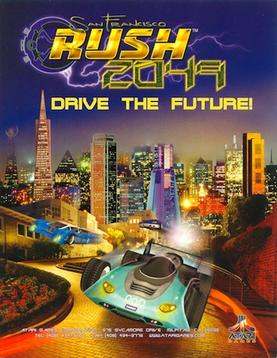
San Francisco Rush 2049 is a racing video game developed and manufactured by Atari Games for arcades. It was ported to the Nintendo 64, Game Boy Color, and Dreamcast by Midway Games West. The arcade machine was released in 1999; home versions followed in 2000 on September 7 for North America and November 17 for Europe. It is the third game in the Rush series and the sequel to San Francisco Rush: Extreme Racing and Rush 2: Extreme Racing USA. It is the last game in the Rush series to be set in the city of San Francisco and the last released on a Nintendo console. It also serves as the final game for the Atari Games label, which was retired shortly after the arcade release. The Dreamcast version was later re-released as part of Midway Arcade Treasures 3 for the PlayStation 2, Xbox, and GameCube and later for Windows as part of Midway Arcade Treasures Deluxe Edition.

Hydro Thunder is an arcade inshore powerboat racing video game originally released by Midway Games in February 1999 and later released for the Sega Dreamcast as a launch title later that year. It was also released for the PlayStation and Nintendo 64 in early 2000. This game is part of Midway's Thunder series of racing games, which includes Offroad Thunder, 4 Wheel Thunder, and Arctic Thunder. Hydro Thunder Hurricane, a sequel to Hydro Thunder, was later released for the Xbox 360 on July 27, 2010 on Xbox Live Arcade.
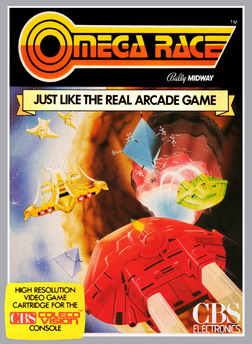
Omega Race is a shoot 'em up arcade video game designed by Ron Haliburton and released in 1981 by Midway. It is the only arcade game with vector graphics that Midway created.

Off Road Challenge is a video game developed and published by Midway. The game was originally released in 1997 for arcades using the Midway V Unit hardware. It is part of the Off Road series which began with Ivan 'Ironman' Stewart's Super Off Road.
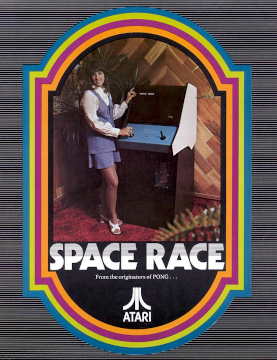
Space Race is an arcade game developed by Atari, Inc. and released on July 16, 1973. It was the second game by the company, after Pong (1972), which marked the beginning of the commercial video game industry along with the Magnavox Odyssey. In the game, two players each control a rocket ship, with the goal of being the first to move their ship from the bottom of the screen to the top. Along the way are asteroids, which the players must avoid. Space Race was the first racing arcade video game and the first game with a goal of crossing the screen while avoiding obstacles.

Cruis'n is a series of racing video games originally developed by Eugene Jarvis for Midway Games and published by Midway and Nintendo. The series distinguishes itself from other racing games with its over-the-top presentation and fast-paced gameplay, featuring a wide variety of vehicles and tracks based on a variety of real world locations. The series debuted in North American and European arcades in 1994 with the release of Cruis'n USA, which, along with Killer Instinct, was advertised as running on Nintendo's Ultra 64 hardware. Two sequels followed, Cruis'n World and Cruis'n Exotica, which featured new vehicles and tracks. All three games were released for the Nintendo 64 as well, with Exotica also being released for the handheld Game Boy Color. The next game in the series, Cruis'n Velocity deviated from the traditional arcade gameplay of the series and was released for the Game Boy Advance.

Sea Wolf is an arcade video game designed by Dave Nutting and released by Midway in 1976. It is a video game update of an electro-mechanical Midway game, Sea Devil, itself based on Sega's 1966 electro-mechanical arcade submarine simulator Periscope. The game was released in Japan by Taito. In Sea Wolf, the player, piloting an unseen submarine, launches torpedoes vertically in an attempt to sink ships moving horizontally across the screen before time runs out. The screen is viewed through a faux periscope mounted on the cabinet.
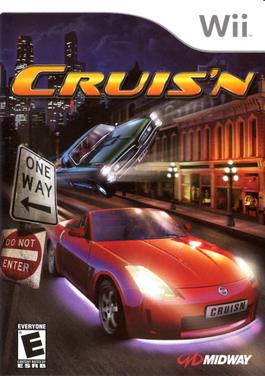
Cruis'n is a racing game for the Wii released in 2007. It was originally released as The Fast and the Furious in arcades in 2004, based on the Fast & Furious franchise and developed by and published by Raw Thrills. The Wii version was ported by Just Games Interactive and published by Midway.

Speed Race is a 1974 arcade racing video game developed and manufactured by Taito and released under the titles Racer and Wheels in North America by distributor Midway Manufacturing in 1975. Designed by Tomohiro Nishikado, the gameplay involves the player using the attached steering wheel to maneuver a car alongside a fast vertical scrolling road. The objective is to score points by driving past other cars without colliding with them; more points are awarded for driving faster. Players must do this under a 90-second time limit, which ends the game when it runs out. The gameplay concepts were adapted from two earlier driving electro-mechanical games: Kasco's Mini Drive (1958) and Taito's Super Road 7 (1970).

Race Drivin' is a driving arcade game originally released by Atari Games in 1990. Players must test drive several high-powered sports cars on stunt and speed courses. The game is the sequel to 1989's Hard Drivin' and was part of a new generation of games that featured 3D polygon environments. Unlike most racing games of its time, it attempted to model real world car physics in the simulation of the movement of the player's car. Like Hard Drivin', the game is unique among video games in that it includes a true force feedback steering wheel, an ignition key, a four-speed shifter, and three foot pedals: an accelerator, a brake, and a clutch. Released in August 1990, approximately 1200 units were produced at the time of its release for roughly US$9,000 each.

















